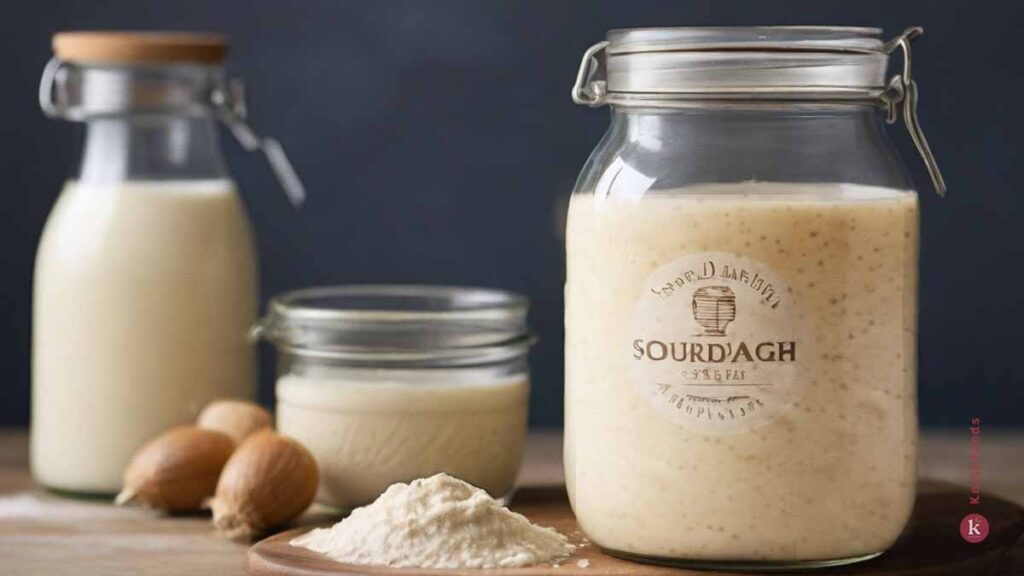
Sourdough bread, a staple of artisan baking, owes its unique flavor and texture to the sourdough starter. This starter is not just an ingredient but a living entity, consisting of flour and water fermented by wild yeast and bacteria. It’s the heart of sourdough bread-making, influencing everything from the bread’s rise to its tangy taste.
Understanding Sourdough Starter
A sourdough starter is a simple yet complex mixture. At its core, it’s just flour and water, but over time, it cultivates an ecosystem of wild yeast and beneficial bacteria. These microorganisms are responsible for not only leavening the bread but also giving sourdough its characteristic flavor.
- What is a sourdough starter? Essentially, it’s a homemade yeast that’s far more flavorful than its store-bought counterparts. For an in-depth understanding, consider exploring resources like The Sourdough School, which delves into the health benefits of sourdough and the science behind it.
- The science behind the starter: The interaction between flour and water activates the natural yeast and bacteria present, leading to fermentation. This process is crucial for developing the starter’s leavening power.
Creating Your Sourdough Starter

Making a sourdough starter from scratch is a rewarding experience that connects you to the ancient art of bread-making. Here’s a simple guide to get you started:
- Mix equal parts of flour and water in a clean jar or container. The mixture should have a thick, paste-like consistency.
- Cover the mixture loosely to allow air in but keep pests out. A breathable cloth or a jar lid slightly ajar works well.
- Feed your starter daily by discarding half of it and replenishing it with fresh flour and water. This process, known as feeding, is vital for maintaining a healthy and active starter.
For more detailed guidance on managing your sourdough starter, King Arthur Baking offers a comprehensive sourdough guide that covers everything from starting from scratch to troubleshooting common issues.
Advanced Care for Sourdough Starter
Maintaining a sourdough starter requires attention and care. Here are some tips for keeping your starter healthy:
- Regular feedings are crucial, especially in the first few weeks.
- Watch for signs of activity: Bubbles and a pleasant, slightly sour smell are indicators of a healthy starter.
- Troubleshooting: If your starter seems sluggish, consider changing the flour type or adjusting the water ratio.
Baking with Sourdough Starter
When your starter is bubbly and active, it’s ready to be used in baking. Here’s how to incorporate it into your recipes:
- Preparing the starter: Use the starter when it’s at its peak activity for the best rise.
- Incorporating into recipes: Replace commercial yeast with your starter for a unique flavor and texture.
FAQs on Sourdough Starter
- How often should I feed my sourdough starter? Daily feeding is recommended, especially in the beginning.
- Can I use all-purpose flour for my starter? Yes, but whole wheat or rye flour can offer more nutrients for the yeast.
- What should I do if my starter smells bad? A bad smell can indicate contamination. Starting over may be the best option.
- How can I make my sourdough bread more sour? Adjusting the fermentation time and temperature can influence the sourness.
For a deeper dive into the fermentation process and how it affects sourdough, the science of sourdough fermentation is thoroughly explored in scientific literature and can be accessed through resources like ScienceDirect.
This article provides a comprehensive guide to understanding, creating, and maintaining a sourdough starter, offering practical advice and scientific insight to both novice and experienced bakers. By following the steps outlined and utilizing the external resources provided, readers can embark on a rewarding journey into the world of sourdough baking.
- Fermentation, wild yeast, hydration, proofing, gluten development, artisan bread, crumb texture, sour flavor, levain, feeding schedule, discard recipes.
